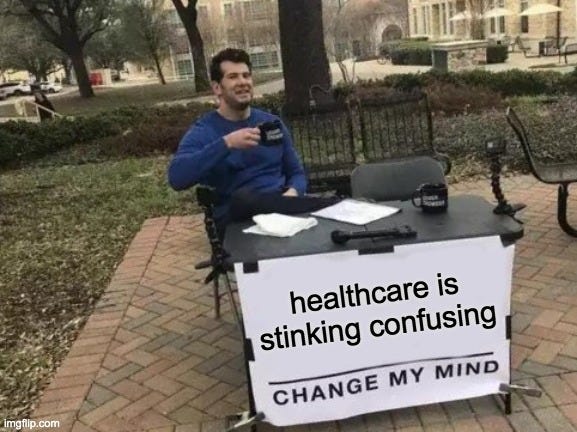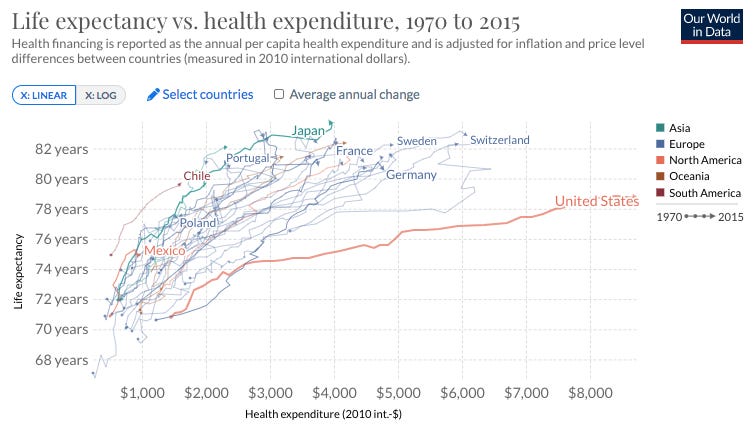Alright, so the first topic of the week comes from a Scottish Coog:
“Good morning guys. I would like to hear either of your takes on the American healthcare system. Thanks.”
- Ruben
I know nothing of healthcare, Ruben, absolutely nothing.
So let’s learn via some half-assed internet research (HAIR).
Issues, We Got Health Issues
Data from the Organisation for Economic Co-operation and Development paints a bleak picture of “health” in the United States.
For instance, the United States spent the highest percentage (18.8%) of GDP on health care out of all countries tracked by OECD in 2020.
Despite that spending, the United States ranks 36th in average life expectancy.
While I can’t find a chart from 2020, I can find something from 2015. Note how life expectancy for the US flatlines compared to price of expenditure — meaning the US is not efficient in turning dollars into health.
On top of that, 2019 data shows that the US has the highest suicide rate, highest chronic disease burden, and highest rate of obesity. Also, we have about 8.6% of people living life without health insurance in the US.
Oof.
But Maybe It’s Not That Bad?
Ok, but there are a few different places where health in the US can hang its hat:
the US has the highest survival rate for cancer
the US ranks as the second best country in terms of doctor skills
survival after the age of 80 is easiest in the US (yay, i guess?)
Eek, ok, well that’s not that inspiring of a list. (therefore, enjoy this pasta’d emoji image, which fits the performance of our healthcare system.)
Private Health Insurance
Luckily the US seems to compound the issue of an unhealthy population with an exceedingly high cost of health insurance.
Private health insurance is the most prevalent way to get access to healthcare in the US, with 63.2% of persons under the age of 65 utilizing some form of private insurance (data poached from the CDC).
The price of private health insurance in the US depends on location, but the range can be found within $4,300-$8,500, which means citizens with private insurance pay between $330-$700 per month (the equivalent of a car payment).
Of course, this number increases and decreases according to the age of insurance purchaser, with younger individuals getting cheaper insurance during their healthy years and older individuals paying a hefty premium as their bodies wane. For example, here is how monthly insurance costs can rise and fall over the years (according to data gathered by moneygeek, so it’s probably only like 80% correct):
Users can also pay for different types of insurance plans, wherein younger folks might look for a plan with cheaper monthly premiums and high costs as a bet on being healthy, while old folks might prioritize expensive monthly plans that allow for tons of flexibility when the plan actually has to be used.
Author’s note: There is a lot I could write about here regarding the ACA’s bronze, silver, gold, and platinum levels, but I have a job, sorry, so I’ll just link to this :)
Public Health Insurance
The CDC says that 27.7% of persons in the US utilize some form of public insurance, which comes in two forms.
Medicare — Medicare is a federal program for senior citizens (boomers over 65). Centers for Medicare & Medicaid Services report that the US spent $829 billion on Medicare in 2020. Medicare essentially subsidizes the cost of inpatient houses, doctor visits, and other benefits based on whether citizens paid Medicare taxes back in the day.
Medicaid — Medicaid was greatly expanded by the ACA in 2014 and currently has about 76 million citizens utilizing its benefits. Medicaid gives low-income children and their families access to mandatory benefits like hospital services, x-ray services, and medical transportation. US citizens with an income under 133% of the poverty line and ineligible for Medicare should have access to some sort of Medicaid (though it not available in every state). I think this chart is up to date:
Kram’s Thoughts On US Healthcare After HAIR
I’m hitting my hour time limit, so I’ll pause here. Might have to do another deep dive on this topic.
US healthcare doesn’t really look all that pretty from where I’m standing, but, again, this was just some half-assed internet research (HAIR).
The TL;DR for this article seems like: the US’ healthcare system is inefficient and both private and public healthcare are sort of broken.
However, something I didn’t cover here is the tradeoff the US makes with other countries whom rank very high on healthcare lists (like Germany and Sweden and Netherlands and Canada). Based on what I’m seeing, the US tax rate is actually way lower than many of these countries, meaning that the data is skewed to show that our health care costs are wayyyy higher than other countries (even tho some European healthcare costs are hidden via national taxation).
I would have to do a lot more thinking on this topic to form an opinion, but at least this document might give someone a decent starting place in doing research (it definitely was fun to read and research about).
Really appreciate the question Ruben.
Looking forward to the next topic on Thursday.
- Kram








